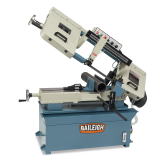I like the idea of using an actuator to
lift the horizontal band saw above the work after making a cut. Not liking so much the idea of using an actuator to control the downward movement versus the present "leaky cylinder" mechanism. The optimal speed of the downward "cutting movement" depends on a LOT of things, among them the type of material being cut, the width of the band saw blade, the pitch of the band saw teeth, the linear velocity of the band saw blade, the amount (and type) of liquid coolant applied during the cut, and probably the phase of the moon... just kidding on that last one! However, dull blades should be replaced, rather than the "feed" adjusted to accommodate them. The time-honored method of adjusting the down-feed for this type of saw is by "trial-and-error," starting with almost zero down-feed for unknown materials, and then experimenting with linear blade velocity and increasing the down-feed rate until acceptable results are achieved.
While it may be possible, even desirable, to fit a linear actuator to replace the current mechanism, you will also need some means to determine how fast the linear actuator is moving down while cutting, as well as limit switches that remove power to the actuator at the extremes of actuator movement. Sensing motor current is not definitive. Too many variables affect the motor loading. What you need (for the downward motion only) is a position transducer, such as an LVDT (Linear Variable Differential Transformer), which would be my choice, or perhaps a "
string potentiometer" which would also serve well in this application. You can easily make your own string potentiometer using a multi-turn potentiometer with a small drum affixed to its shaft to wind the string around. Some mechanical design is required, but if you study the "slide rule" type of tuning mechanism, found on some multi-band radios, you will get some ideas. Off-the-shelf string potentiometers have a built-in spring (much like a clock main-spring) that retracts the string and allows the potentiometer wiper contact to return to its starting position when string tension is released, so you may want to try that approach in a DIY design.
If you do decide to use a string potentiometer, you can make a simple tachometer or actuator velocity sensor by connecting a small permanent-magnet DC motor, with a double-ended shaft, in tandem with the potentiometer shaft... or just wind a few turns of the string around the DC motor shaft.
Even without a tachometer, your microprocessor can measure the changes in displacement at fixed intervals of time to determine downward actuator velocity, and then use a look-up table or an algorithm to determine optimal downward cutting speed. You won't need this when you need to use the actuator to raise the (heavy) band saw blade mechanism after a cut has been made. Depending on the actuator, you may just simply tell it to go "full speed ahead" until the blade mechanism reaches a limit stop.
If I ever learn how to weld, I will certainly need to purchase a horizontal band saw to cut stock to length. I wonder how much those puppies cost on the used market? And I wonder where in the world I would find space for it...

